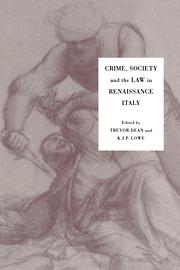Book contents
- Frontmatter
- Contents
- Illustrations
- List of contributors
- Preface
- 1 Writing the history of crime in the Italian Renaissance
- 2 Criminal justice in mid-fifteenth-century Bologna
- 3 The judicial system in Florence in the fourteenth and fifteenth centuries
- 4 The incidence of crime in Sicily in the mid fifteenth century: the evidence from composition records
- 5 Theology, nature and the law: sexual sin and sexual crime in Italy from the fourteenth to the seventeenth century
- 6 Practical problems in the enforcement of Italian sumptuary law, 1200–1500
- 7 The prince, the judges and the law: Cosimo I and sexual violence, 1558
- 8 Intervention by church and state in marriage disputes in sixteenth- and seventeenth-century Florence
- 9 The writer and the man. Real crimes and mitigating circumstances: il caso Cellini
- 10 The political crime of conspiracy in fifteenth- and sixteenth-century Rome
- 11 Fighting or flyting? Verbal duelling in mid-sixteenth-century Italy
- 12 Banditry and lawlessness on the Venetian Terraferma in the later Cinquecento
- 13 Mihi vindictam: aristocratic clans and rural communities in a feud in Friuli in the late fifteenth and early sixteenth centuries
- Index
1 - Writing the history of crime in the Italian Renaissance
Published online by Cambridge University Press: 14 October 2009
- Frontmatter
- Contents
- Illustrations
- List of contributors
- Preface
- 1 Writing the history of crime in the Italian Renaissance
- 2 Criminal justice in mid-fifteenth-century Bologna
- 3 The judicial system in Florence in the fourteenth and fifteenth centuries
- 4 The incidence of crime in Sicily in the mid fifteenth century: the evidence from composition records
- 5 Theology, nature and the law: sexual sin and sexual crime in Italy from the fourteenth to the seventeenth century
- 6 Practical problems in the enforcement of Italian sumptuary law, 1200–1500
- 7 The prince, the judges and the law: Cosimo I and sexual violence, 1558
- 8 Intervention by church and state in marriage disputes in sixteenth- and seventeenth-century Florence
- 9 The writer and the man. Real crimes and mitigating circumstances: il caso Cellini
- 10 The political crime of conspiracy in fifteenth- and sixteenth-century Rome
- 11 Fighting or flyting? Verbal duelling in mid-sixteenth-century Italy
- 12 Banditry and lawlessness on the Venetian Terraferma in the later Cinquecento
- 13 Mihi vindictam: aristocratic clans and rural communities in a feud in Friuli in the late fifteenth and early sixteenth centuries
- Index
Summary
This volume has a distinguished predecessor in that published in 1972 and edited by Lauro Martines: Violence and Civil Disorder in Italian Cities, 1200–1500. Although the emphasis of that book was specifically on violence and not on crime, much of that violence was criminal, and thus the overlap between the two books is considerable, even if the periods covered do not match entirely. But in the twenty-year interval between them, fundamental changes in the study of Italian crime in the Renaissance have taken place. Most immediately noticeable is the change in the body of scholars: instead of eleven English-speaking men, there is a mixture of male and female academics from Europe, America and Australia, among them several Italians. The vast bulk of research in this area is now carried out by Italians. The type of crime (or disorder) considered worthy of interest has also changed. In 1972, Martines claimed that the historian of violence was most attracted to political disorder, group crime, institutionalized violence and ‘personal or private violence of the kind that promises a view of the [historical] mainstream’. Now, a much broader range of crime and disorder is appraised.
The political geography of Italy, in the present as in the Renaissance, has resulted in the triumph of local and regional history at the expense of ‘national’ or comparative analysis. Accordingly, the chronology of crime in the peninsula as a whole lacks anything but a very basic outline.
- Type
- Chapter
- Information
- Crime, Society and the Law in Renaissance Italy , pp. 1 - 15Publisher: Cambridge University PressPrint publication year: 1994
- 2
- Cited by



